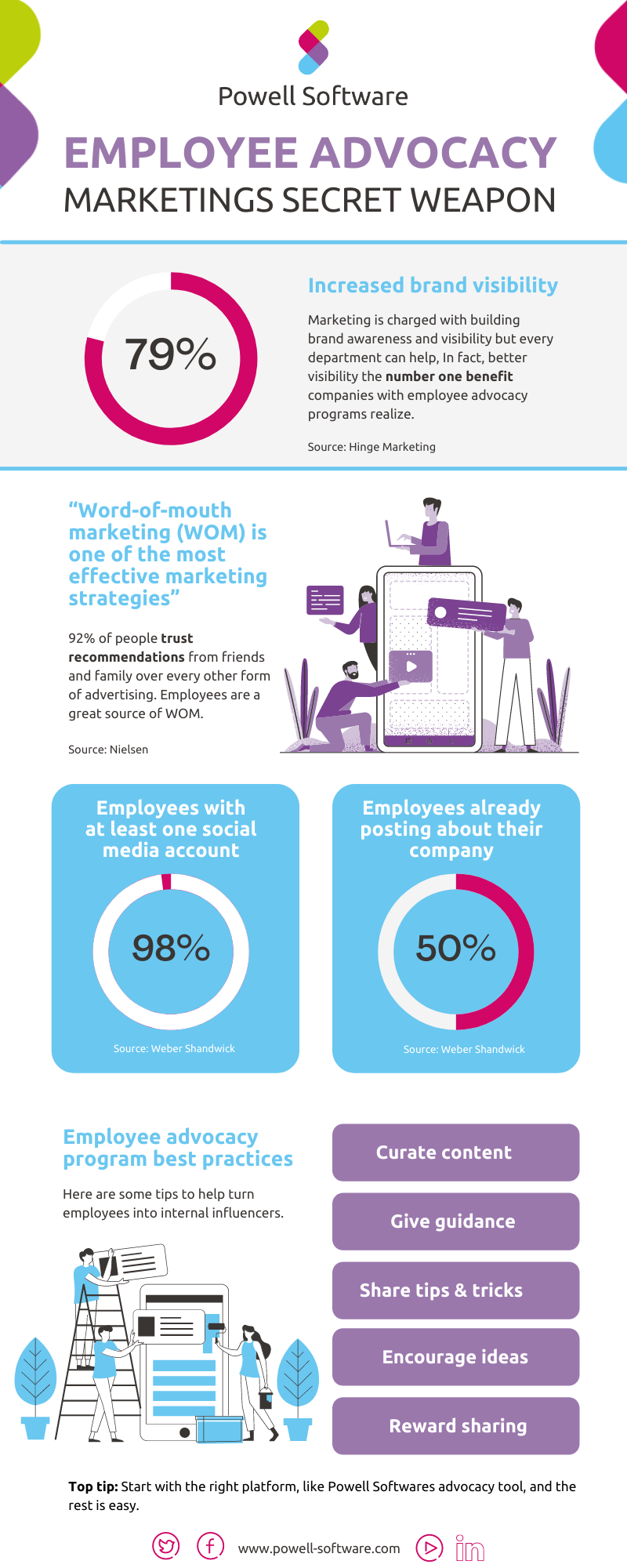Marketing is charged with building brand awareness and visibility, a task that requires significant investment and effort. From inbound to social, SEO, and SEA, there’s no shortage of digital communication channels available to your marketing team. However, there’s no reason the responsibility should stay within the marketing department.
Every department can help build brand visibility. It’s the number one benefit companies with an employee advocacy marketing program realize.
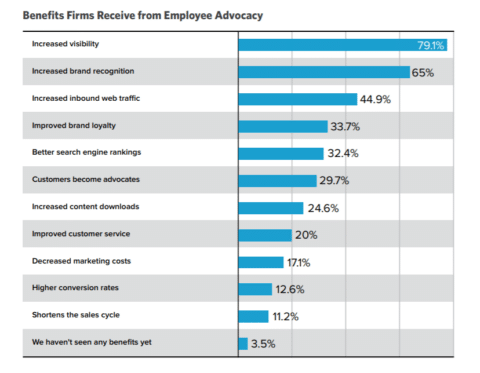
Why does internal influencer marketing work?
Employees are the secret to improved organic reach because of their ‘influencer’ status. When they post about a product, it’s considered a recommendation, not an ad. Consumers do not like ads, and 96% don’t trust them.
Yet in 2021 62% of marketers were prepared to invest in external influencer marketing, instead of maximizing their internal ambassador network.
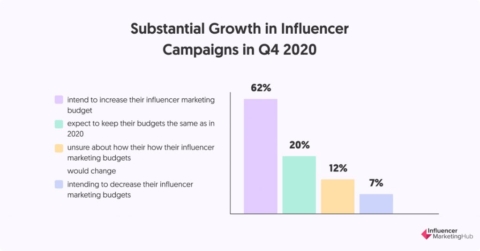
Imagine you could harness the power of people and improve brand visibility for free with no sponsorship disclosure required. Employee advocacy programs are the solution.
Why are employee advocates the ultimate internal influencers?
Micro-influencers
Employees are the original ‘micro-influencer, which usually refers to people with over 1,000 social media followers. However, this status can encompass anyone with a loyal and engaged audience. Micro-influencers are real gems, generating higher engagement than ‘mega-influencers’. It’s not unusual for employees to have a few hundred LinkedIn connections or a thousand Instagram followers. Employees are often happier to share on LinkedIn, their professional network.

As subject-matter experts, and with followers being made up of ex-colleagues, classmates, friends, and family, employees’ posts gain more interaction. Now that the LinkedIn algorithm only shows posts to first connections and requires more engagement to go viral, this network is a gold mine.
Trusted sources of information
Employee advocacy isn’t typically part of the job description. Employee brand advocates share because they find the content useful, not because they must. And when they share, it boosts the credibility of the content. That’s why word-of-mouth marketing (WOM) is one of the most effective marketing strategies. 92% of people trust recommendations from friends and family over every other form of advertising.

So, an employee advocacy platform, like Powell Software creates, that allows people to share content with their close network is the secret to more organic reach.
Contribute to a more inclusive content strategy
Content creators are always looking for inspiration and ideas. It can be difficult to keep up with every new development, so when a team of people is helping, everyone benefits.
- Marketing gets new ideas and can build great content.
- Sales can suggest topics they know potential customers will benefit from.
- IT can share a wealth of knowledge.
- HR sees improved engagement.
It’s a win-win.
Subject-matter experts
Marketing helps make complex topics more understandable to a wide audience. They cut through jargon and information overload to deliver the right message. At the same time, they’re not technical experts. A marketer could be targeting banks but have no background in finance.
An employee advocacy marketing tool, like Powell Softwares, leverages the skills and knowledge of employees in two ways.
- Employees can easily recommend links or interesting articles. If it’s relevant, marketing can add it to the advocacy homepage for other employees to share.
- Content managers get ideas for topics that could be created internally.
- Employees can participate in marketing efforts and build a sense of belonging.
- HR can reap the benefits that come from highly engaged employees.
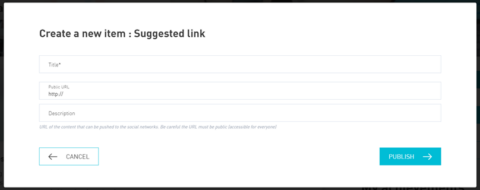
- User-generated content (UGC) can also be submitted in the employee advocacy tool. Anyone can upload an article or content idea. The marketing manager can take the idea and help curate or edit it further. Once it’s ready to post, then marketing might add to the company blog and advocacy area for everyone to share.
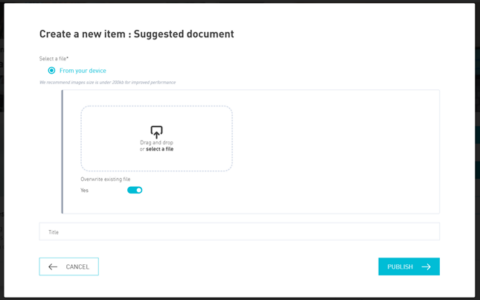
- Employees can suggest technical topics marketing wouldn’t have thought of.
- It allows employees to expand their skills and knowledge. Someone working in IT might write the best articles but was never given the opportunity.
- HR and management benefit from a connected workforce and higher morale.
Check out his video to see our employee advocacy tool in action.
Increased reach and connect with the right audience
Social networks are always introducing new algorithms, making it harder for marketers to gain the same organic reach they used to.
Employee advocates are the secret to getting the message to more people and delivering useful content to contacts that mightn’t have come across it otherwise. In fact, 98% of employees are already using social media and half post company content. So the base for employee sharing on social media is built.
Take the example of a company whose ideal customer is an accountant. It makes sense that the company’s finance team would have relevant contacts on their LinkedIn. They studied and worked in the area, building up a network.
If those employees share an article that contains lots of helpful information for accountants, suddenly, the right content is reaching the right people.
The fact that their connections are more likely to interact with the post and share it with their contacts will help grow organic reach. All marketing has to do is make sure employees are willing and easily able to share content.
Sales should also be running to share content, 73% of salespeople who use social media in their strategy outperform their colleagues.
Download the Infographic PDF: Employee Advocacy: Marketings Secret Weapon
6 Best practices for employee advocacy marketing
Internal brand ambassadors have huge potential, but getting everyone motivated to share. Marketing can help support the roll-out of an employee advocacy marketing program with some best practices.
- Curate content – Provide everyone with the right content. Keep control over what internal advocates are sharing externally.
- Give guidance – Remember, marketing is the expert in social sharing. Guide employees on the right hashtags to use, the best time of day to post, who to tag, and how often to post.
- Support those less comfortable with social media—Not everyone is a LinkedIn expert. There may be people who never post on their social channels. In the beginning, marketing can help by creating description templates or talking one-on-one with anyone who’s really unsure.
- Encourage ideas—Sharing ideas for content can be intimidating. Let people know that the advocacy platform is open to everyone.
- Reward sharing – Employees need to benefit themselves. Gamification features, like points, badges, and competing for a spot on the leaderboard, are a great way to reward people.
- Use the right tools – It goes without saying that marketing and employees need to be supported with the right tool to make an employee advocacy marketing program a success. Powell Software’s employee advocacy tool integrates into your digital workplace. We create a space in the corporate intranet that gathers content so employees can share it on social media in one click.
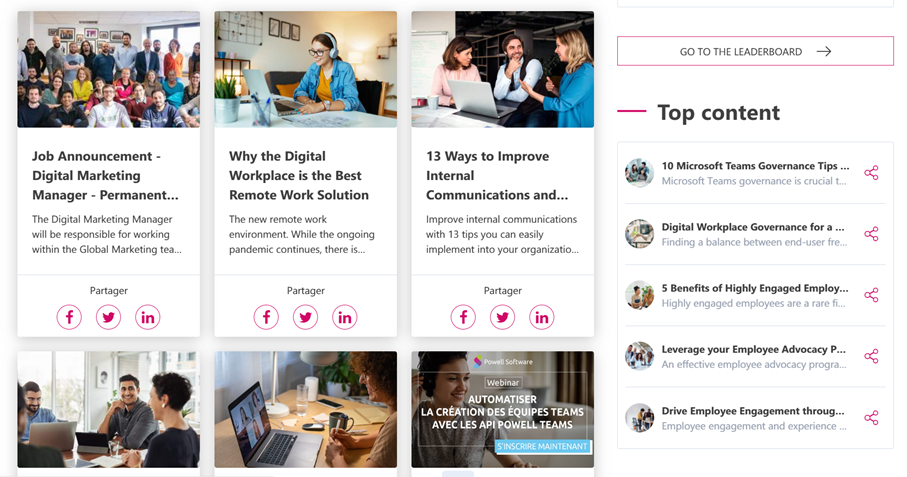
It’s also easy to suggest links and articles. A leaderboard encourages friendly competition, and employees are rewarded for sharing.
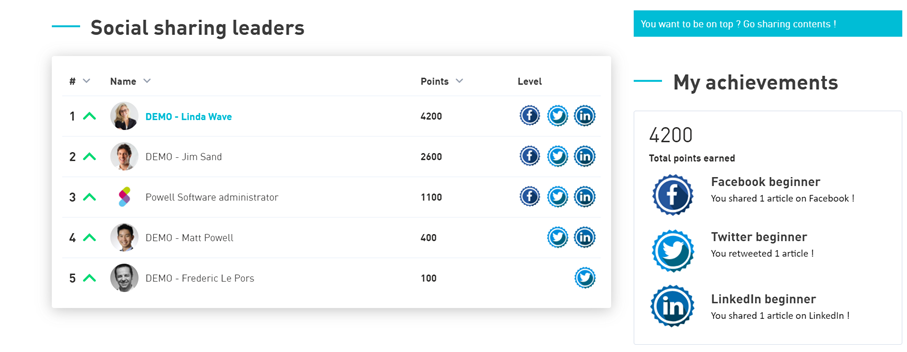
Employee advocacy programs are a company-wide initiative with benefits for nearly every department. Yet marketing stands to gain more than most if it takes some time to educate employees and promote the platform. Once the program is up and running, marketing only has to link content already created or help edit recommended ideas further. After that, marketing can start to see the results in increased organic reach and improved visibility. Employee advocacy programs really are marketing’s secret weapons.


